An interview with Kara Moses, a part of our on-going Interviews with Young Scientists series.
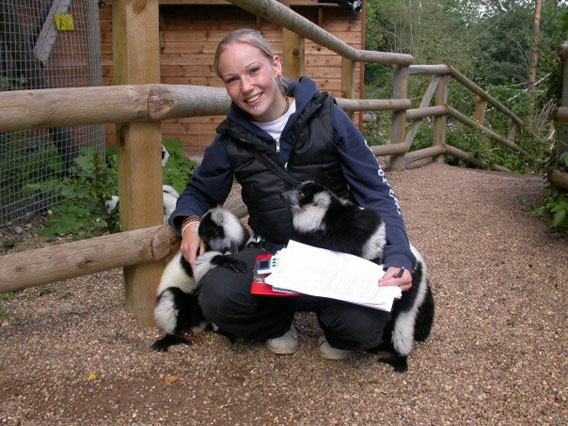
Kara Moses with the ruffed lemurs at Dudley Zoo, conducting undergraduate research.
Kara Moses may have never become a biologist if not for a coin toss. The coin, which came up heads and decided Moses’ direction in college, has led her on a sinuous path from studying lemurs in captivity to environmental writing, and back to lemurs, only this time tracking them in their natural habitat. Her recent research on ruffed lemurs is attracting attention for documenting the seed dispersal capabilities of Critically Endangered ruffed lemurs as well as theorizing connections between Madagascar’s lemurs and the carbon storage capacity of its forests. Focusing on the black-and-white ruffed lemur’s (Varecia variegata) ecological role as a seed disperser—animals that play a major role in spreading a plant’s seeds far-and-wide—Moses suggests that not only do the lemurs disperse key tree species, but they could be instrumental in dispersing big species that store large amounts of carbon.
“[Ruffed lemurs] are the largest of the seed-dispersing lemurs, with the largest gape, so they can swallow the big seeds that other animals can’t—meaning tree species with the biggest seeds may depend exclusively on ruffed lemurs to disseminate their seeds; they range relatively far during their daily travels, so can potentially carry seeds over long distances; their digestive system affects seeds in a way that makes them germinate more successfully and more quickly; and their droppings are very loosely held together, and broken up further by falling through the branches from the high canopy where they live […] All of these things are good news for seed germination,” Moses explains in a mongabay.com interview.
As the largest mammals native to Madagascar, lemurs play a number of key roles in the ecosystem including seed dispersal, and, as the biggest of the seed-dispersing lemurs, ruffed lemurs may be one of the only animals on the island to disperse big trees.
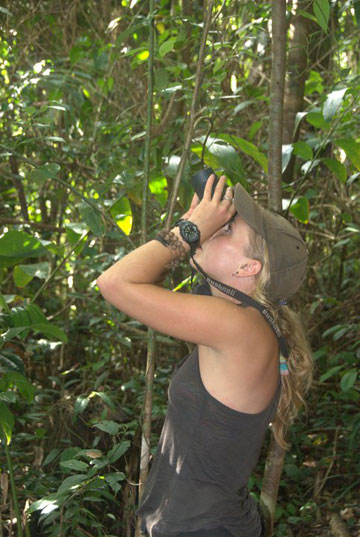 Searching for elusive lemurs, SE Madagascar. Photo by Daniel Austin. |
“Generally speaking, trees that produce large seeds tend to be large, slow-growing, long-lived and have relatively dense wood, so they’re able to store more carbon over their lifetimes than small-seeded trees which, conversely, are generally smaller, faster-growing, shorter-lived, and have lighter wood. If the trees that produce large seeds don’t get their seeds dispersed—a likely scenario if large seed-dispersing animals like ruffed lemurs disappear—they begin to die out,” Moses explains.
If the ruffed lemurs vanish, so too would the large trees, changing the entire forest structure to favor small, fast-growing trees.
“The forest then becomes one composed mainly of trees with low carbon-storage potential, and the carbon-storage capacity of the whole forest is affected,” says Moses. “This may have obvious global implications, with respect to climate change for example.”
Moses says more research is needed, but a recent study has boosted the concept, finding “a striking overlap between the areas where great apes occur and the level of carbon storage, indicating potential synergies between great apes and carbon conservation.”
However, forests which are still standing in Madagascar may have already felt the loss of its helpful lemur: the black-and-white ruffed lemur’s population is thought to have fallen by 80 percent in less than three decades. The lemur’s decline has largely been driven by deforestation with hunting an additional, but still secondary, problem. However, Moses says recent government instability in Madagascar has also worsened matters.
“There is effectively no legitimate government at the moment, following the coup in 2009. The international community refuses to recognize the new ‘government’ and has pulled a lot of aid. Laws are not being effectively enforced—there has been so much illegal rosewood logging in the north, which the ‘government’ has itself been implicated in, or at least profiting from allowing it to be exported—this is an unfortunate consequence of the international community cutting off aid that has forced the government to seek funds from illicit sources to stay afloat, and it has been devastating for wildlife,” Moses explains. She says that given the high-levels of extreme poverty in Madagascar, conservation cannot move forward without taking human needs into account.
“As long as people are struggling to survive, forests will continue to be threatened. Many people are aware of how destructive practices like slash-and-burn agriculture are, but have no alternatives—so alternatives need to be provided. Providing training for sustainable agriculture practices for example, has shown some success. To be successful, conservation efforts need to be supported by political will from the top and grassroots community support from the bottom.”
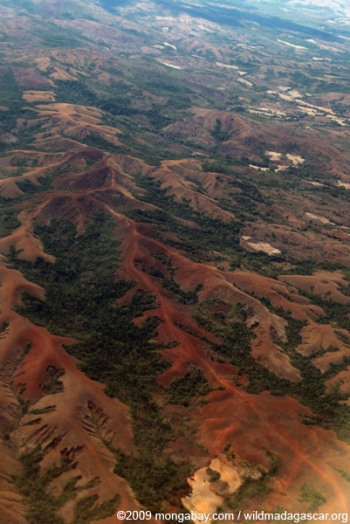 Deforestation has endangered many species and caused erosion throughout Madagascar. Photo by: Rhett A. Butler. |
Like the toss of the coin, Moses’ career thus far has been unpredictable. She has eschewed the “straight” path taken by many young researchers, moving between scientific research and popular environmental writing.
“I began to feel that primatology was too focused—whole ecosystems are going extinct, all of life on earth is threatened, so for me focusing on one species seemed too narrow,” she says. “I felt I had to spread the net wider and try to change people’s values by communicating with them and raising awareness—that’s why I changed direction from primatology to writing. But studying lemur and forest ecology has given me an understanding of the complexity and fragility of the natural world, and the science behind it, which continues to inform my writing.”
As to what’s next, Moses says she hopes to continue to work toward finding and highlighting solutions to the global ecological crisis through writing, activism and perhaps more ecological research.
“I believe that a radical shift in perspective is needed for life on Earth to survive, and I think that the necessary process of awakening is beginning to happen already. We are starting to realize the reality of climate change, of species loss, of overpopulation etc… So much progress has been made already and so much great work is being done, though there are still huge challenges ahead,” Moses says.
In a January 2012 interview Kara Moses discussed how black-and-white ruffed lemurs may facilitate carbon storage, the link between poverty and environmental destruction in Madagascar, and why passion is a must in any student contemplating a career in science.
INTERVIEW WITH KARA MOSES
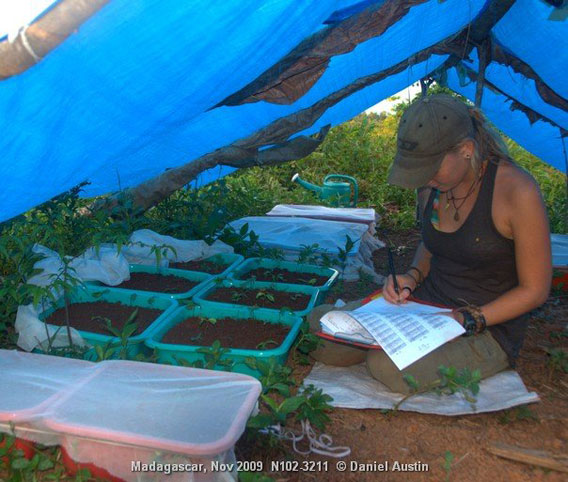
Kara recording germination trial progress, SE Madagascar. Photo by Daniel Austin.
Mongabay: What is your background?
Kara Moses: I’ve been fascinated with animals and the natural world since a very young age, and spent a lot of my childhood scratting around in the mud, climbing trees, playing with insects, collecting frogs etc. I always wanted to go into a career with animals or nature; for most of my youth I had dreams of being a vet. My first degree was in Biological Sciences, specializing in Environment, which I did at the University of Birmingham (UK) and absolutely loved. Later I did a Master of Research degree in Primatology at Roehampton University (London) which I also loved. Things could have gone very differently though. When I first went to university I was studying medical science—I really don’t know why I chose that subject, I think I had a moment of madness and just wanted a challenge; it was a pretty full-on course. Anyway I hated it and after a year I decided to change courses but had no idea what I wanted to do instead. I was seriously considering philosophy, when one day on campus I bumped into a friend who was studying medicine and was equally disillusioned with his studies. He was thinking about switching to biology which sounded like a good option to me, as philosophy did to him, so we decided to flip a coin to decide and made a pact to both do whatever the coin decided—philosophy or biology. It landed on heads for biology and that was that. I’ve often reflected that I wouldn’t be where I was now if it weren’t for that coin.
I’ve since retrained as an environmental journalist, a career I fell into by an equally random moment of chance, but that’s another story…
Mongabay: How did you become interested in primates, specifically lemurs?
Kara Moses: For my undergraduate dissertation I studied niche separation in four lemur species in a mixed-species enclosure at Dudley Zoo. I remember being gutted at the time that I couldn’t afford to go to the far-flung tropical field sites where all my friends were doing their dissertations. I thought I’d drawn the short straw—they were going to Brazil, Honduras and Africa, and I was going to Dudley (any readers from the UK will understand why I was disappointed!)—but it turned out to be one of the best things that’s ever happened to me as it eventually led me to Madagascar. So I suppose I took the scenic route to the exotic location, though it didn’t seem very scenic at the time. At the zoo, the black-and-white ruffed lemurs in particular captivated me and I decided that I had to do something to help save them from extinction, so I became a primatologist. It was a long journey—it took me two years of working three jobs to save the £11,000 I needed to do the Masters, and I had so many setbacks, such as major political unrest breaking out a month before I was due to fly which delayed the trip by six months, but eventually my dream of studying them in the wild came true.
BLACK-AND-WHITE RUFFED LEMUR SEED DISPERSAL
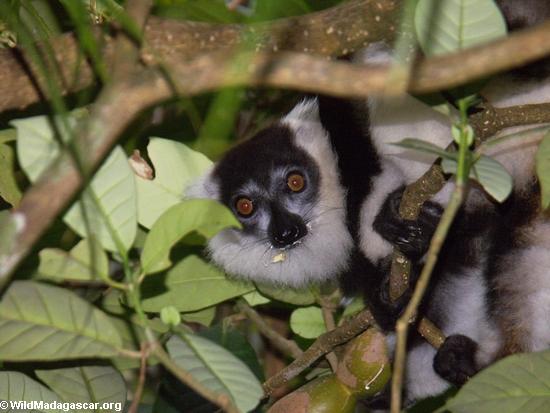
Black-and-white ruffed lemur (Varecia variegata) feeding on a tamarind. Photo by: Rhett A. Butler.
Mongabay: Why do you think seed dispersal by black-and-white lemurs has been neglected until now?
Kara Moses: It is quite well documented that lemurs are important seed dispersers. It’s difficult to say why the black-and-white ruffed lemur had received little attention, despite being an ideal candidate for seed dispersal. It may be partly due to the difficulties involved in studying them—they are only found in the eastern rainforests of Madagascar, where the terrain and conditions are often pretty heavy going. They also spend most of their time in the high canopy, making fecal sample collection—a crucial part of seed dispersal studies—quite a challenge.
Mongabay: What makes black-and-white ruffed lemurs a particularly apt seed disperser?
Kara Moses: Ruffed lemurs have a whole suite of physical, behavioral and ecological characteristics that lend themselves to effective seed dispersal. Ruffed lemurs are the most fruit-reliant of all the lemurs and have a very diverse diet, meaning they can disperse a large number of seeds and high diversity of species; they are the largest of the seed-dispersing lemurs, with the largest gape, so they can swallow the big seeds that other animals can’t—meaning tree species with the biggest seeds may depend exclusively on ruffed lemurs to disseminate their seeds; they range relatively far during their daily travels, so can potentially carry seeds over long distances; their digestive system affects seeds in a way that makes them germinate more successfully and more quickly; and their droppings are very loosely held together, and broken up further by falling through the branches from the high canopy where they live. This means that seeds are highly scattered when they reach the ground, so they suffer less from competition and predation by seed-eating animals. All of these things are good news for seed germination.
Mongabay: How could lower-end dispersal distances characterize Madagascar’s forest structure?
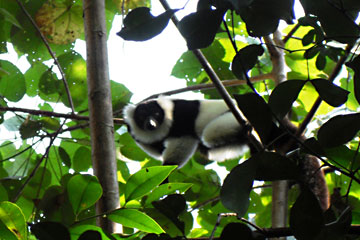 Study subject ‘PinkBlue’ peers back at her observers. Photo by Kara Moses. |
Kara Moses: If you compare the available data for how far lemurs disperse seeds with that for other primates, they seem to do so over relatively shorter distances. This might be because of the energy-conservation strategies that lemurs use to cope with the unpredictability of fruit in Madagascar’s forests, which results from the island’s rather erratic and severe climate. Strategies such as spending a lot of time resting or eating more leaves than usual are unlikely to be compatible with long dispersal distances.
This may then affect the forest, as population genetic theory predicts that the more spatially restricted seed dispersal is, the more likely plant populations are to develop local genetic differentiation. Local endemism (and therefore local genetic differentiation) is prevalent on Madagascar. It might be that ecological processes (such as seed dispersal) and evolutionary ones (such as speciation) on Madagascar in general are quite spatially restricted, perhaps as a result of the isolation (due to e.g. rivers or watersheds, thought to be a mechanism for driving local endemism) of populations, which may have restricted the movements of animals and the seeds carried in their guts.
These are quite tentative hypotheses—we really need much more data to explore the ideas further.
AN UNEXPECTED PAIRING: CARBON AND LEMURS
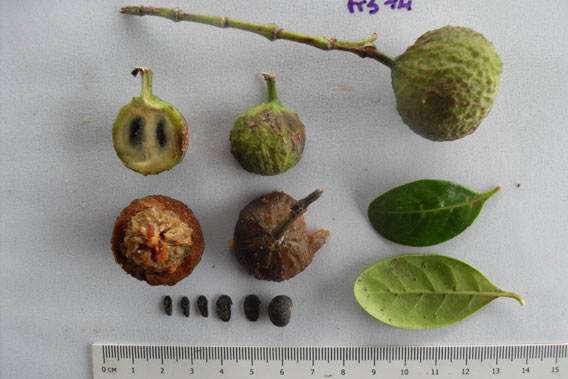
Sample of a fruit eaten by ruffed lemurs. Photo by Mialy Razanajatovo.
Mongabay: What is the possible connection between black-and-white ruffed lemur seed dispersal and carbon sequestration?
Kara Moses: Generally speaking, trees that produce large seeds tend to be large, slow-growing, long-lived and have relatively dense wood, so they’re able to store more carbon over their lifetimes than small-seeded trees which, conversely, are generally smaller, faster-growing, shorter-lived, and have lighter wood. If the trees that produce large seeds don’t get their seeds dispersed—a likely scenario if large seed-dispersing animals like ruffed lemurs disappear—they begin to die out. Species with small seeds that can be dispersed by many animals, and species with wind-dispersed seeds, may then gain a competitive advantage and begin to dominate the forest (this is already playing out in South American forests where large seed dispersing animals have been extirpated by overhunting). The forest then becomes one composed mainly of trees with low carbon-storage potential, and the carbon-storage capacity of the whole forest is affected. This may have obvious global implications, with respect to climate change for example.
Mongabay: What more research is needed to verify this theory?
Kara Moses: These links are only just being made, and as the processes involved take place over long periods of time it may be too late before we can confirm the links between seed dispersal and climate change. But work is being done at the moment. A new study has just revealed a striking overlap between the areas where great apes occur and the level of carbon storage, indicating potential synergies between great apes and carbon conservation. This is what we need more of—evidence for direct links.
Mongabay: Could other large-seed dispersers similarly be connected to carbon sequestration?
Kara Moses: Absolutely. Ruffed lemurs are just one example.
Mongabay: What happens to Madagascar’s eastern forests if we lose the black-and-white ruffed lemur?
Kara Moses: Losing any species from an ecosystem always has knock-on effects, and potentially triggers waves of cascading extinctions, especially if keystone species such as these lemurs are lost. Other animals may shift their behavior to fill the niche gap that would appear with the loss of the lemurs, and this again could have knock-on effects elsewhere in the delicate web of interactions that make up ecosystems. There is the danger that the largest-seeded tree species, for which ruffed lemurs may be the sole dispersers, could be lost as they have no means by which to propagate. Then we’re back to the situation I just described; altered forest structure and dynamics and consequently reduced carbon-storage capacity.
LEMUR ON THE EDGE

Black-and-white ruffed lemur hanging in a tree. Photo by: Rhett A. Butler.
Mongabay: The black-and-white lemur is nearly extinct. How did this happen?
Kara Moses: Both species of ruffed lemur (black-and-white, and red) are severely threatened by habitat loss, and also hunting in some areas. Madagascar has lost 90 percent of its forest cover since humans arrived on the island, taking with it many large species of lemur, and the deforestation continues today. It’s one of the poorest countries in the world and most of the population lives on less than a dollar a day so it’s a pretty tough situation—people need to survive but the forests are rapidly disappearing. Habitat loss is largely due to slash-and-burn agriculture but logging, mining and even tar sands now, are ever-increasing pressures on Madagascar’s forests too.
Mongabay: What still threatens this species?
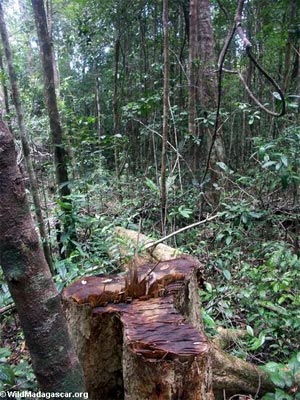 Illegal rosewood logging in Masoala National Park. Photo by Rhett A. Butler |
Kara Moses: As I just mentioned, the old threats of habitat loss and hunting are still big problems, and the current political instability in Madagascar is not helping.
There is effectively no legitimate government at the moment, following the coup in 2009. The international community refuses to recognize the new “government” and has pulled a lot of aid. Laws are not being effectively enforced—there has been so much illegal rosewood logging in the north, which the “government” has itself been implicated in, or at least profiting from allowing it to be exported—this is an unfortunate consequence of the international community cutting off aid that has forced the government to seek funds from illicit sources to stay afloat, and it has been devastating for wildlife. The coup was such a blow to conservation in Madagascar—the ousted president, Marc Ravalomanana, was far from perfect but really on board with protecting Madagascar’s natural heritage. He fulfilled his promise to massively increase the amount of protected areas on the island in quite a short space of time, a legacy of his which will hopefully continue. Lack of political will is often the major stumbling block for conservation efforts, so it was just fantastic to have someone in such an influential position so sympathetic to conservation. More recently, the threat of tar sands is looming, large tracts of land are being sold to foreign companies for agriculture and of course climate change is starting to make a real impact. The picture is rather a bleak one, but there is so much great work being done as well that there are reasons to stay positive.
Mongabay: What conservation work is necessary to save it?
Kara Moses: Greater habitat protection and legislation enforcement (which will need a legitimate and supportive government), as well as linking up fragmented areas of forests. In Manombo where I did my research there was essentially no guarding of the forest, no reason for people not to go in and cut trees down—and who can blame them when they are living such a hand-to-mouth existence? They don’t have a lot of choice. Conservation has to be integrated with community development work to be successful and sustainable, local communities need to be on board with it. For example, educating local people, especially children, around conservation and ecological issues to improve understanding and appreciation of the natural environment helps change people’s attitudes, which essentially drive people’s behavior—when they have a choice. Too often people don’t have that choice though—ultimately, poverty underlies a lot of the conflicting needs of people and the environment. As long as people are struggling to survive, forests will continue to be threatened. Many people are aware of how destructive practices like slash-and-burn agriculture are, but have no alternatives—so alternatives need to be provided. Providing training for sustainable agriculture practices for example, has shown some success. To be successful, conservation efforts need to be supported by political will from the top and grassroots community support from the bottom.
Mongabay: You’ve had an eclectic career, including working as an environmental journalist. How did such experiences inform your own research?
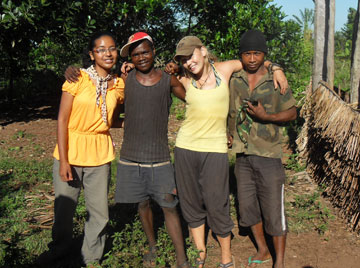 Mialy, Tia, Kara, and Andry: the camp team at Manombo. Photo courtesy of Kara Moses. |
Kara Moses: The research and writing feed into each other. Reporting on diverse issues around the world, from huge dam projects and corruption in Borneo, to transport issues in London and unsustainable fishing practices in Asia gave me a bigger perspective on environmental issues and allowed me to see Madagascar’s problems in context.. I began to feel that primatology was too focused—whole ecosystems are going extinct, all of life on earth is threatened, so for me focusing on one species seemed too narrow. I felt I had to spread the net wider and try to change people’s values by communicating with them and raising awareness—that’s why I changed direction from primatology to writing. But studying lemur and forest ecology has given me an understanding of the complexity and fragility of the natural world, and the science behind it, which continues to informs my writing. Having experienced the real-life situation on the ground, I’m able to appreciate the difficulties involved in conservation and environmental problems. Seeing first hand how people live in countries like Madagascar really brings home an appreciation of how complex the problems that we face in trying to reconcile development and conservation really are.
Mongabay: You’ve had a lot of success so far. Any recommendations you would give students interested in pursuing conservation research?
Kara Moses: Choose to study something you are passionate about. Throughout the years I’ve been studying and researching, through all the set backs and challenges, the thing that has kept me going is passion. Because I care about the lemurs and the forests, I’ve always been able to find the energy to continue when the going got tough. I am a firm believer in being able to do whatever you want to do if you really put your mind to it. Perhaps paradoxically, you also need to know when to let go when things don’t work out exactly as you planned: the old paradox of “everything matters, nothing matters.” Sometimes you just need to take a different direction to the one you thought. But with determination, creativity, tenacity and good humor you can get through anything. It’s also really important to connect with people who are already working in the area you’re interested in. Put yourself in the right place at the right time: go to and talk to people at academic conferences—I’ve had countless opportunities come out of conversations at conferences—public meetings and talks, meetings of organizations and groups, email interesting people, just find as many ways as possible to meet the people behind the work you’re interested in and show them you’re keen. Finally, volunteer, get some experience. Everyone seems to want experience these days.
Mongabay: What’s next for you?
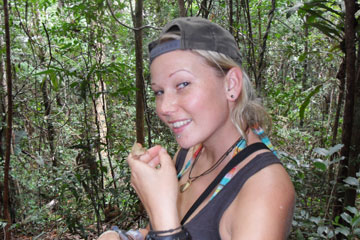 Kara with a tiny Brookesia chameleon, SE Madagascar. Photo courtesy of Kara Moses. |
Kara Moses: How best to contribute to the environmentalist movement remains a huge question for me, and one that I doubt I will ever answer. I’m interested in the underlying reasons for why we’re destroying the planet, the “deep ecology” perspective—I think the solutions have to come from questioning at this level. We’ve become disconnected from nature—particularly in the West there is this belief that we are somehow separate from nature, that plundering the environment will not affect us. We live in a society based on exponential growth, but on a planet that is finite—something has to give, and I think we’re heading to that point soon. I believe that a radical shift in perspective is needed for life on Earth to survive, and I think that the necessary process of awakening is beginning to happen already. We are starting to realize the reality of climate change, of species loss, of overpopulation etc… So much progress has been made already and so much great work is being done, though there are still huge challenges ahead. How I fit into all that I don’t know—perhaps through writing, through campaigning and activism, maybe I’ll return to Madagascar to do some more research one day. I don’t have a set path and have no idea what the future holds but hope that my cumulative efforts will have some kind of positive impact.
Kara Moses is an environmental journalist, activist and primatologist www.KaraMoses.com
Click here
to hear a talk about lemur seed dispersal and the experiences of conducting field research, given by Kara at an Anglo-Malagasy Society meeting
in October 2011.
Articles by Kara Moses on Mongabay.com
Primatologists: the best hope for apes is the best hope for us
Power, profit, and pollution: dams and the uncertain future of Sarawak
Forest Recovery Programs in Madagascar
Borneo ablaze: forest fires threaten world’s largest remaining population of orangutans
Saving the tsingy forests in Madagascar
World’s rarest tortoises stolen
Paper on lemur seed dispersal
Related articles
Photo: Tiny lemur discovered in Madagascar forest
(01/08/2012) A new species of mouse lemur has been discovered in eastern Madagascar, report researchers from Germany. The species is described in a recent issue of the journal Primates.
Cultural shifts in Madagascar drive lemur-killing
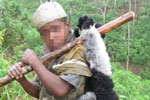
(12/15/2011) Conservationists have often found that some cultural norms, religious beliefs, and taboos play a role in holding back traditional peoples from overusing their environment. Examples of such beliefs include days wherein one cannot hunt or fish, or certain species or regions that are off limits to exploitation. But the influence of the modern world can rapidly extinguish such beliefs, sometimes for the better, in other cases not. In many parts of Madagascar, lemurs are off the menu. These primates, found only in Madagascar, play a big role in Malagasy ‘fady’ or taboo-related folk stories: lemurs are protectors and, in some cases, even relatives. However, according to a new paper in PLoS ONE an influx of migrants, widespread poverty, lack domestic meat, and poor law enforcement has caused a sudden rise in eating lemurs, many of which are already near-extinction due to habitat loss.
Madagascar tree diversity among the highest worldwide

(12/12/2011) In terms of biodiversity, the hugely imperiled forests of Madagascar may be among the world’s richest. Researchers estimate that the island off the coast of Africa is home to at least 10,000 tree and shrub species with over 90 percent of them found no-where else in the world. With little baseline data collected on Madagascar’s ecosystems, a new study, the first ever of tree diversity in Madagascar lowland rainforests, hopes to begin the process. Published in mongabay.com’s open access journal Tropical Conservation Science, the new study surveyed tree species in eastern Madagascar’s Betampona Special Reserve.
Forgoing bushmeat hunting has health toll in Madagascar, says study
(11/22/2011) Conservationists shouldn’t overlook the detrimental health impacts of shifting local populations away from subsistence bushmeat hunting, says a new study.
Critically Endangered lemurs disperse seeds, store carbon

(11/13/2011) Many tropical plants depend on other species to carry their progeny far-and-wide. Scientists are just beginning to unravel this phenomenon, known as seed dispersal, which is instrumental in supporting the diversity and richness of tropical forests. Researchers have identified a number of animal seed dispersers including birds, rodents, monkeys, elephants, and even fish. Now a new study in the Journal of Tropical Ecology adds another seed disperser to that list: the Critically Endangered black-and-white ruffed lemur (Varecia variegata). Capable of dispersing big tree species, the black-and-white ruffed lemur may even play a big role in carbon sequestration.
Photos: 40% of Madagascar’s reptiles at risk of extinction
(11/10/2011) 40 percent of Madagascar’s terrestrial reptiles are threatened with extinction due to habitat loss and over-collection for the pet trade, reports the International Union for Conservation of Nature (IUCN) in its latest update of the Red List of Threatened Species.
Madagascar interim president: sell rosewood stocks
(11/09/2011) Madagascar should sell its stocks of illegally logged rainforest timber, Madagascar’s interim leader Andry Rajoelina told the BBC in an interview.







